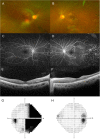Case of catastrophic antiphospholipid syndrome presenting as neuroretinitis and vaso-occlusive retinopathy
- PMID: 33298003
- PMCID: PMC7727181
- DOI: 10.1186/s12886-020-01755-9
Case of catastrophic antiphospholipid syndrome presenting as neuroretinitis and vaso-occlusive retinopathy
Abstract
Background: Ocular involvement in catastrophic antiphospholipid syndrome (CAPS), a rare, life-threatening form of antiphospholipid syndrome (APS) that results in multiorgan failure and a high mortality rate, has rarely been reported.
Case presentation: A 15-year-old girl presented with sudden vision blurring in both eyes. She had marked optic disc swelling and macular exudates in the right eye and intra-arterial white plaques, a few retinal blot hemorrhages, and a white ischemic retina in the left eye. Systemic examination revealed she had acute kidney injury with thrombotic microangiopathy (TMA), multiple cerebral infarcts, valvular dysfunction, and a high titer of triple aPL. Thus, she was diagnosed with CAPS involving the brain, eyes, heart, and kidneys. Plasma exchange and the administration of glucocorticoids, immunoglobulin, warfarin, and rituximab brought a sustained recovery of the TMA, visual symptoms, and echocardiographic findings.
Conclusions: Ocular involvement of both vaso-occlusive retinopathy, an APS-related thrombotic microangiopathy, and neuroretinitis, a non-thrombotic microangiopathy, can occur as an initial presentation of CAPS.
Keywords: Antiphospholipid syndrome; Catastrophic antiphospholipid syndrome; Neuroretinitis; Thrombotic microangiopathy; Vaso-occlusive retinopathy.
Conflict of interest statement
The authors declare that they have no competing interests.
Figures


Similar articles
-
Neuroretinitis as an initial presentation of lupus-like illness with antiphospholipid syndrome.Lupus. 2010 Dec;19(14):1662-4. doi: 10.1177/0961203310377220. Epub 2010 Aug 11. Lupus. 2010. PMID: 20702528
-
The complex treatment including rituximab in the Management of Catastrophic Antiphospholid Syndrome with renal involvement.BMC Nephrol. 2018 Jun 8;19(1):132. doi: 10.1186/s12882-018-0928-z. BMC Nephrol. 2018. PMID: 29884138 Free PMC article.
-
Catastrophic antiphospholipid syndrome: Lessons from the "CAPS Registry".Med Clin (Barc). 2024 Aug;163 Suppl 1:S31-S35. doi: 10.1016/j.medcli.2024.02.011. Med Clin (Barc). 2024. PMID: 39174151 Review. English, Spanish.
-
Purtscher-like retinopathy following coronary artery bypass grafting in an antiphospholipid syndrome patient: a case report.BMC Ophthalmol. 2023 May 4;23(1):197. doi: 10.1186/s12886-023-02935-z. BMC Ophthalmol. 2023. PMID: 37142991 Free PMC article.
-
Successful Treatment of Catastrophic Antiphospholipid Syndrome Using Rituximab: Case Report and Review of the Literature.Medicina (Kaunas). 2021 Aug 31;57(9):912. doi: 10.3390/medicina57090912. Medicina (Kaunas). 2021. PMID: 34577835 Free PMC article. Review.
References
Publication types
MeSH terms
Substances
LinkOut - more resources
Full Text Sources
Miscellaneous

